The genetic background of modern day Europe can often be a complicated topic to talk about. History often brings the migrations of faraway peoples, which is how the Indo-Europeans merged with the proto-populations of Old Europe . As a result, today many of us speak a derivation of the ancient proto-Indo-European language. But what if we tell you that there are still some people left in Europe that preserve those seemingly lost links with the ancient times and the Europe as it was originally?
One of these peoples are the Basques, a European ethnic group that numbers around three million people that inhabit their traditional homeland called the Basque Country . The region is located at the Western end of the Pyrenees and covers parts of Northern Spain and Southern France. Largely considered to be remnants of the pre-Indo-European populations of Europe, the Basques are unique in so many aspects. And today we are getting to know one of their popular myths, with one question in mind: Is it really a myth?
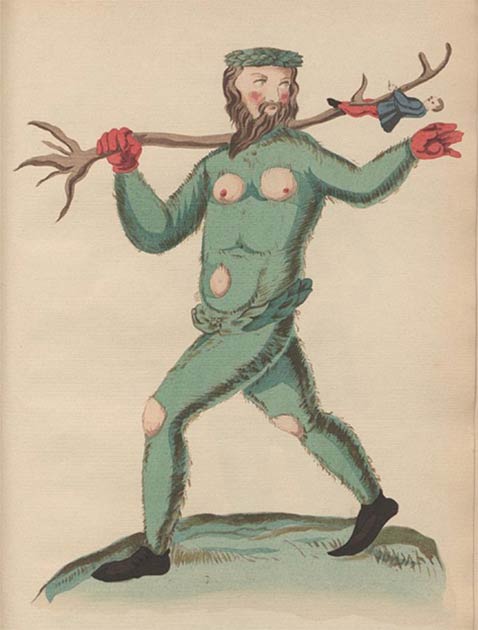
From the yeti to bigfoot, or even the wild man, mythology filled with mysterious hairy beasts living in remote corners of the world is not new. ( Public domain )
The Basque People and Their Connection To Pre-Indo-European Peoples
Before we delve deeper into the nature of this colorful myth, we need to get acquainted with the Basque people. In their own language, they call themselves Euskaldunak, and their homeland they call Euskal Herria. Crucial for our story are the Basque language and the origins of the Basque people. Unlike other European languages, Basque is completely unrelated to Indo-European languages.
Basque is a language isolate, unrelated to any other known living language. It is widely regarded that as such, Basque is one of the very few pre-Indo-European languages that survived to the present day. Let us remind you that almost all European languages today descent from a single, proto-Indo-European ancestor language.
Several unique theories have been presented which attempt to prove that Basque is indeed a remnant of Old Europe. Old Europe is a term used to denote Europe before the widespread migrations of Indo-European peoples. One such proof is found in several Basque words: aizto (knife), aizkora (axe), aitzur (hoe), aiztur (tongs). Such words derive from the word haitz meaning stone, which points to the existence of the language in a period when stone tools were in use.
But just how much do the Basque genetically have in common with the pre-Indo-European peoples is debatable. There is no doubt that at some point mixture occurred, as is the case with the entire populace of Europe. There is still a lot of proto-European DNA in the blood of all Europeans. On closer analysis of some of the oldest European myths and traditions, we should be able to find remnants of oral tradition, passed down through the generations to survive in the form of myth. These kinds of oral traditions could tell us more about an era, many thousands of years ago, when the people of Europe were starkly different in their customs. Could the Basque myth of Basajaun hold the key to understanding the peoples of Old Europe?
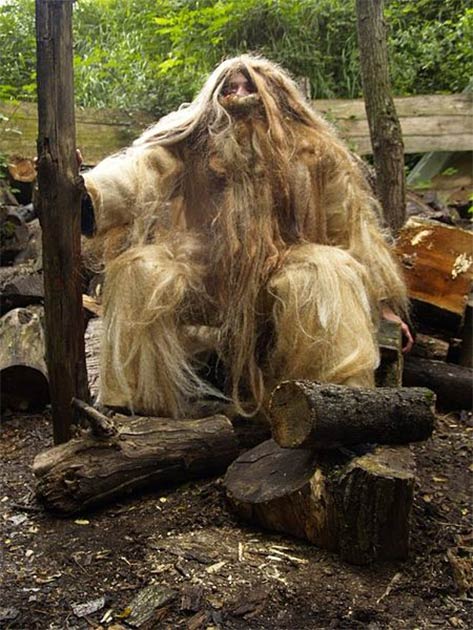
Basajaun, meaning “Lord of the Woods”, is described as a robust, large and hairy hominid who lives in the forests. ( CC-BY-SA-1.0)
Benevolent Lord of the Woods: Is the Myth of the Basajaun Based on Fact or Fiction?
In Basque mythology there exists a creature known as the Basajaun. Translated, it means “Lord of the Woods”. Basajaun is described as a robust, large, and hairy hominid who lives in the forests. He also has a female counterpart and companion known as a Basandere. Now, here is where the Basque myth becomes very interesting. The Basajaun is believed to have built megaliths, protected flocks of livestock, as well as introduced agriculture and iron-working to humans. He is also said to have lived in caves, often deep in the woods, of which there are many in the Pyrenees. In general, the Basajaun is depicted as a benevolent creature, a sort of a protector of the woods, and a protector of flocks and shepherds. Other rural legends still give him more attributes of a folk guardian: it is said that a Basajaun yells and hollers from the mountains whenever a storm is coming, and warns the peasants and the shepherds to take shelter.
But there are far more enigmatic aspects to this myth that quickly tickle our imagination and make us wonder whether or not this myth actually has its roots in fact or fiction. The old stories of the Basque Country describe Basajaun as a teacher. The tales explain that Basajaun knew how to craft tools, and taught people how to create weapons, mills, axels, saws, and how to smelt metals. He also instructed them in the skills needed for crop cultivation, forging, and milling. And to top it all off, the Basajaun was responsible for building megaliths. Depicted as a robust man with a lot of hair on his body, he is depicted as an ancient man in his earliest steps towards civilization. In other words, the description of the Basajaun bears a striking resemblance to the Neanderthals, or even the European Early Modern Humans (EEMH) also known as Cro-Magnons.
If we dig a little deeper, it’s interesting to keep in mind that the Neanderthals persevered in the modern Basque Country for quite a while after disappearing from other parts of Europe. The so-called Iberian Neanderthals persisted in the area of the Ebro River, in the Pyrenees, up until about 35,000 years ago, and perhaps even later. This area coincides almost exactly with the modern Basque Country. It is widely thought that the Neanderthal technology was quite sophisticated, and boasted a complex stone tool industry, weaving, fire use, primitive art, primitive seafaring, primitive music, and so on. The extensive archaeological discoveries in relation to Neanderthals break the usual stereotype of these early hominids as “cavemen” with big clubs. But could the myth of the Basajaun provide even more insights?
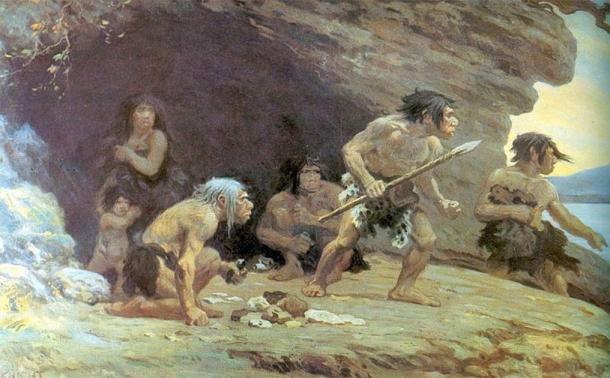
The description of the Basajaun bears a striking resemblance to the Neanderthals, who persevered in the modern Basque Country while they disappeared from other parts of Europe. ( Public domain )
Enduring Stories from an Ancient People
Neanderthals are not known to have erected megaliths, even though they did boast exceptional strength, and are certainly not known for smelting, which came much, much later. Can it be that the Basque people, being old as they are, preserved tales of the earliest contacts between the Neanderthals of the Pyrenees and the European Early Modern Humans (Western Hunter Gatherers) who migrated into the area? It is known that around 16,000 BC the climate got even warmer and allowed the peoples of the Magdalenian Culture to expand in to all corners of Europe.
An interesting theory was put forward in 2008 by the Finnish linguist Kalevi Wilk. Wilk proposed that the Basque language is actually a remnant of a wider language family that was spoken all across Old Europe , before gradually retreading westwards with the approach of the Indo-Europeans and their languages. Even the renowned and eminent scholar, the late Marija Gimbutas, stated firmly that “the Basque language is a pre-Indo-European relic of the ancient western European languages. It is the only indigenous language to survive the Indo-European invasions and cultural influences of the last three thousand years.” In her renowned work entitled The Living Goddess , she reflected thoroughly on the Basque people, and amongst other things, stated confidently that “there is no doubt that the Basques are Old Europeans whose traditions descend directly from Neolithic times.”
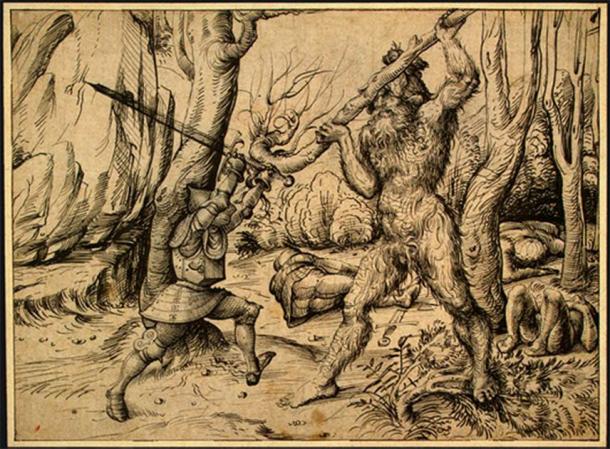
Was the myth of the Basajaun born from an actual contact with some of the last remaining Neanderthals of the ancient world? ( Public domain )
In 2012 the renowned Genographic Project of the National Geographic Society, released an important study that showed a detailed DNA analysis of Basque peoples. It confirmed their unique genetic patterns that totally distinguished them from surrounding populations, supporting the theory that there is a partial or complete genetic continuity of modern Basque people with the Paleolithic and Mesolithic natives of the region.
The idea that the myth of the Basajaun was born from an actual contact with some of the last remaining Neanderthals of the ancient world can certainly seem far-fetched. Indeed, some aspects of the Basajaun myth simply don’t correspond to what we know about the Neanderthals. For example, as far as we know they weren’t the ones to introduce complex technologies to Cro-Magnons. But even so, I – and many others – firmly believe that the Basajaun myth is in fact a surviving memory of the oldest history of Europe, which naturally had to survive in one of the oldest ethnicities of Europe, the Basques.

The premise of this article is that myth or legend can be born out of a simple encounter between two totally different groups of people. ( Kovalenko I / Adobe Stock )
Contact With Neolithic Settlers: The Birth of the Basajaun Myth
It can be hypothesized that the Basajaun myth speaks of the time when the Basque peoples, isolated Proto-Europeans of the Paleolithic and Mesolithic, who still relied on primitive industries and stone tools, came into contact with the more advanced settlers of the emerging Neolithic cultures. The emerging cultures were megalith builders, who brought with them a string of advanced technologies like agriculture, domestication of animals, refined stone tools, and eventual emergence of metallurgy in the late Neolithic and early Chalcolithic.
Once the dots are connected, the mythical figures of the Basajaun and Basandere take on the form of migrating Neolithic settlers: hairy and clad in furs and skins, they are accompanied by flocks of domesticated animals, they settle in the woods and gradually come in contact with the more primitive Basque peoples, bringing with them new beliefs, the building of megaliths, new tools and new technologies. The wary, primitive and Mesolithic populations would have seen these new arrivals as creatures from the beyond, or mythical protective “Lords of the Woods”. And even long after, when the two groups merged into something new, the isolated Basques preserved their language and identity, and the Neolithic settlers simply remained mythical – giving rise to the Basajaun Myth.
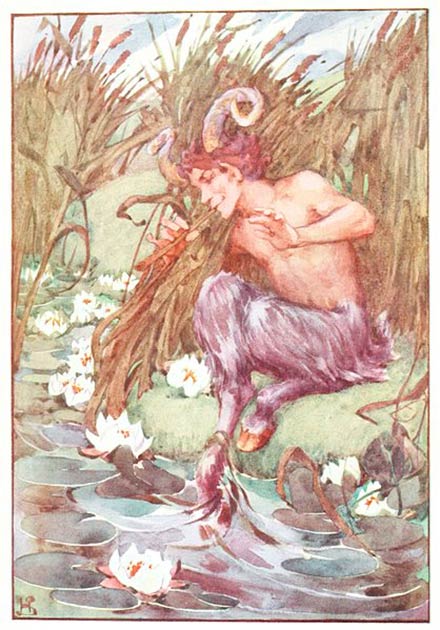
Could an encounter with a rural mountain shepherds of the Balkans, who had a unique tradition of wearing pants made from shaggy goat coat, be the origin of the myth of Pan, the ancient Greek god of the wilds? ( Public domain )
The Simple Birth of a Lasting Myth
A unique theory related to the contact of Indo-Europeans and Old Europeans can show us just how easy it is for a myth or a legend to be born out of a simple encounter from two totally different groups of people. That theory is related to Pan, the ancient Greek god of the wilds, protector of shepherds, flocks, and nature. He is portrayed as a bearded and hairy man, carrying a shepherd’s staff, and with the legs of a goat.
The cult of Pan emerged in Arcadia, the district of the mountain people, culturally separated from other Greeks. And the fun part comes when we study the oldest portrayals of rural mountain shepherds of the Balkans: bearded and hairy, carrying staffs, they had a unique tradition of wearing pants made from shaggy goat coat, the so-called fleece trousers. For a new settler coming in contact with Proto populations of the mountainous Balkans, it can be easy to observe from a distance a unique, shaggy person who seemingly has the legs of a goat, unlike anything ever before seen. And before you know it, a myth is born: mysterious goat-legged shepherds of the high mountains, protecting the flocks.
There are a lot of mysteries still lurking in the history of Europe and the cultures of Paleolithic, Mesolithic, Neolithic, and Chalcolithic. A lot of secrets still hide in the deepest reaches of time, and much is simply unknown. There remain intriguing remnants that beg to be the subject of extensive research: complex megalithic structures, remnants of matriarchal cults and ancestor worship, and unique funerary practices. But thanks to geographical isolation, the Basque people and their Old European language have allowed a crucial glimpse into the ancient history of Europe which tells us one very important thing: a theory does not have to be as clear as daylight in order to bear credibility.
Even when something sounds so stupidly simple and far-fetched, sometimes fact can only make it even closer to the truth. At times we underestimate the combined simplicity and complexity of humans through time, as well as their ability to create colorful myths from things that are slightly hard to comprehend. And once a myth like that settles within the memory of a generation or two, it can survive for centuries to come. Could it be that the myth of Basajaun is a fantastic example of this trend?
The Basajaun myth is fairly simple in its description, and not much about it is known besides the aspects you’ve read above. But even those few snippets of an old Basque story can open the doors to a whirlwind of information that tickles the fancy of all lovers of ancient history. It is an excellent opportunity to revisit the migrations of early Cro-Magnons and western hunter-gatherers (WHG), and to reflect on the migrations of technologically advanced cultures within early Neolithic Europe that slowly created the world as we know it today.
Top image: Could the origin of the Basajaun myth reside in an encounter between the primitive and Mesolithic populations of the ancient Basque Country, and the migrating Neolithic settlers? Source: Gorodenkoff / Adobe Stock
 RSS Feed
RSS Feed















 September 8th, 2020
September 8th, 2020  Awake Goy
Awake Goy  Posted in
Posted in  Tags:
Tags: 













